A planning system stacked in favour of developers
The Cairngorms National Park Authority called in the planning application (see here) for a large extension to the Ptarmigan Restaurant at Cairngorm financed out of public funds on the 14th May. Under their current standing orders they will only report on Objections to Planning Applications which are lodged within 28 days, unless these raise new issues. That deadline, which was not clearly advertised on the CNPA planning portal, was up yesterday.
This is an area of planning where practice in the CNPA lags far behind that of the Loch Lomond and Trossachs National Park Authority. At the special Board Meeting which was called to hear the Cononish Goldmine application (see here) staff even read out objections which had been received after the publication of the Committee Report recommending the development be given the go-ahead, about eight months after the applications had been lodged. In respect of the Ptarmigan extension there have been just five objections, including one from the Scottish Environmental Protection Agency which is labelled “response” NOT “objection” – although they have said twice they have objected because the applicant has failed to provide necessary information – and not a single letter of support.
This is quite a contrast to the planning application for the dry ski slope (see here) where there were a considerable number of both objections and letters of support – many of the latter appearing to be from suppliers to Cairngorm Mountain who were drummed into supporting the project to counter the significant number of objections! The silence about the Ptarmigan is not, I believe, due to lack of public concern but a lack of publicity coupled with the failure to give people sufficient time to respond. The Community Council were given just two weeks to respond, an impossible deadline. The application is also very hard to find on the planning portal and unbelievably, if you search under Cairngorm or Cairngorm Mountain the only current application which appears is the artificial ski slope – its as if Highland Council, which registered the application, wanted to keep it as hidden as possible.
While I apologise to readers for not getting a post out before the deadline most of the issues covered here have not been raised so far in objections and could therefore be taken into account according to CNPA’s standing orders.
All this perfectly illustrates just how our planning system is stacked in favour of developers. HIE announced the plans for Ptarmigan in March 2017 so Natural Retreats has had fifteen months to develop the proposals further. Apart from a consultation event last year, the public have basically been kept in the dark and are now required to digest the content of 25 different documents and hundreds of pages of information in 28 days. I am not surprised that none of the organisations representing people who care about what happens at Cairngorms – from skiers to mountaineers to conservationists has responded. Most depend, to a degree, on voluntary effort and those volunteers are up against publicly supported businesses who employ consultants to work on plans for months. The CNPA, through its rules – and its notable that its landscape and ecological advisers for example have not commented on the application within the 28 day deadline – is making this unfair situation worse.
Reasons why the Ptarmigan Planning Application should be rejected
I believe therefore people should not be put off by the rules and call upon the CNPA to consider “late” comments in cases like this which are of national importance – and, as long of objectors make a new point, this should be considered anyway. Having spent yesterday evening and some of today poring over the application it is clear that in planning terms the application is full of flaws.
Size and shape of the new Ptarmigan building
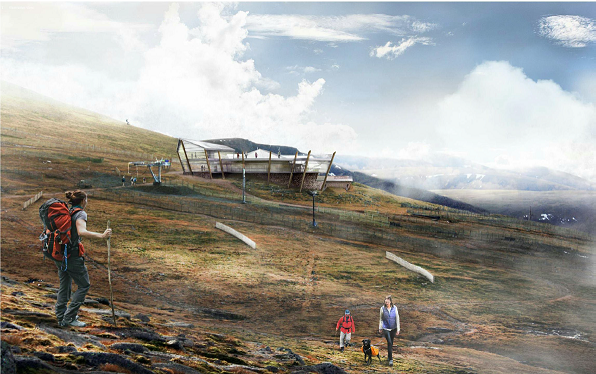
The planning proposal is to retain most of the existing building, re-organise the existing internal space but extend it up and out. The footprint of the building will increase by about a third while the height will more than double from the existing 7.7m to 16.7m, a huge increase. I don’t believe this has properly been taken account of in the landscape impact assessment (see below) but from close up, the building is going to have a very significant impact compared to the existing building.
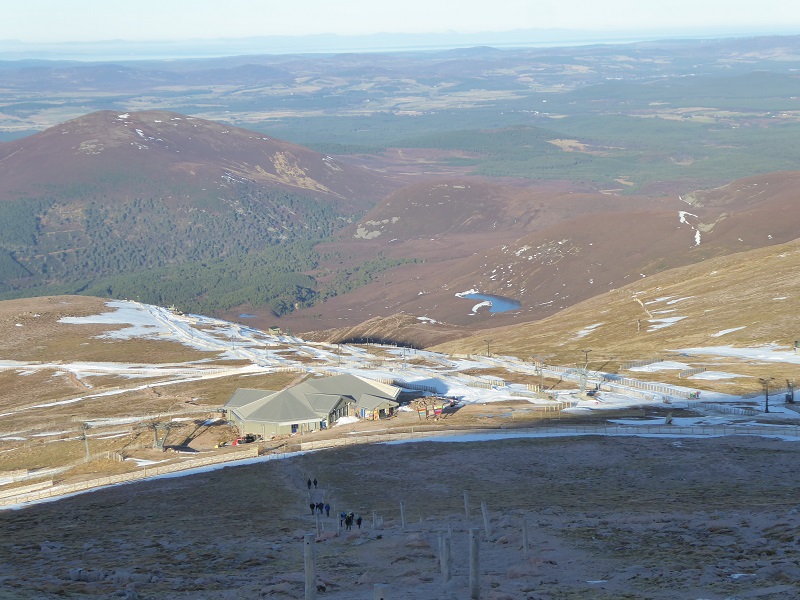
While the existing Ptarmigan building is in a prominent position it is quite squat and its shape is not totally out of place in the curves of the Cairngorms landscape.
While the landscape assessment acknowledges the distinctive rounded landscapes of the Cairngorms, what’s being proposed is a large angular building that juts up above the landscape and bears no resemblance to a tor!

This is supposed to improve “the year round user experience”. It might do for the summer visitor who not allowed to leave the building and view it from outside, but for everyone else the building will be a jarring landscape experience. In order to try and protect as much of the ground as possible, the architects have created a building that leans up and out from narrow foundations. Its very clever but totally out of place in the Cairngorms landscape.
It is therefore clearly contrary to the Local Development Plan which read as follows:
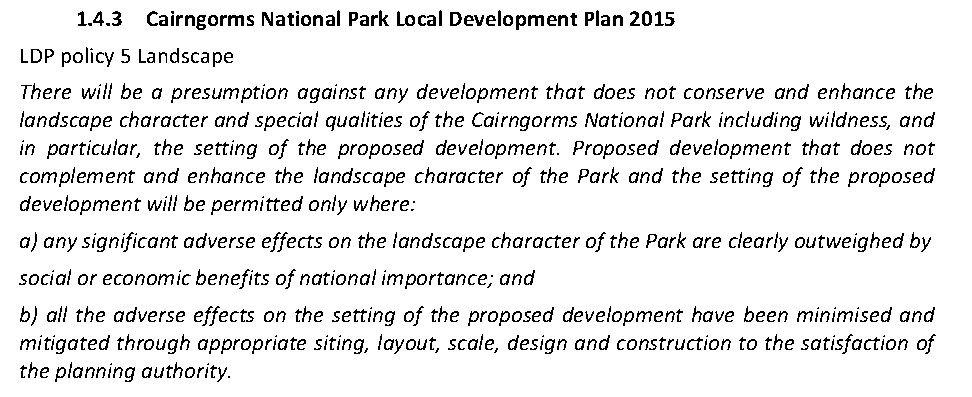
Reason enough for the CNPA to reject the application which, as I will show, will have no social or economic benefits of national importance.
The wider landscape impact of the proposal
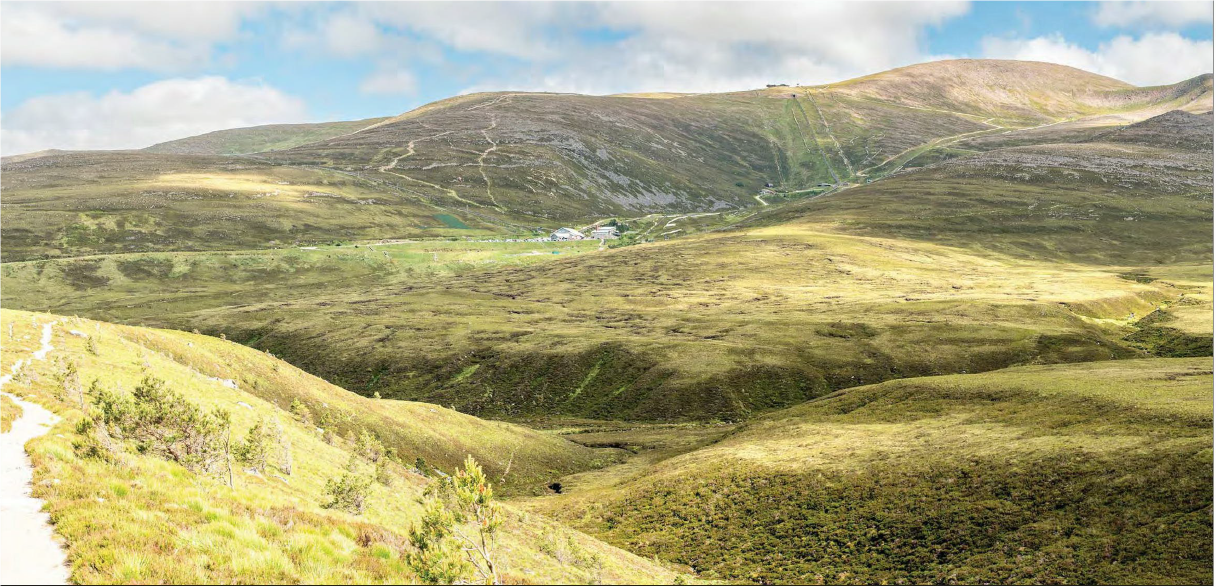
The landscape assessment has considered the visual impact of the new Ptarmigan building from a number of viewpoints, as per the advice, apparently, of the CNPA and generally concluded the impacts are small. The photo above is about the clearest and makes the Ptarmigan look about twice as big as at present. Other photomontages are based on photos taken in poor light or with the summit of Cairngorm in cloud and do not reflect what would be seen on a clear day even if they are a fair reflection of the fact the fact that many visitors to the Ptarmigan, if its enlarged, will be limited to views of swirling mist!
While I believe the visual impacts have generally been underestimated, there are two major omissions in the landscape impact assessment. The first is consideration of the impact of a glass fronted building. This glass will now, after representations from bird interests, apparently be non-reflective and there will be blackout curtains at night to prevent the development appearing like a beacon high up on the mountain. There is, however, no evidence provided that glass has been sourced that will be totally non-reflective and can be guaranteed never to glint in the sun. Unless that can be demonstrated, the current landscape assessment is deficient as shining glass can be seen for miles. Moreover, having refused applications for floodlit skiing here in the past, the strictest of conditions would need to be imposed on blacking lights out at night to preserve the valued dark skies of the Cairngorms. Second, there is no consideration of the increased visual impact of the track which Natural Retreats is proposing to upgrade for construction purposes.
The upgraded construction track
In fact, almost NOTHING is said about how the existing track to the Ptarmigan is to be upgraded. This despite the fact that we know the main impact of many developments in the hills, such as hydro schemes, are inappropriate and poorly designed tracks. This despite the Shieling rope tow track fiasco (see here for example). Instead this, from the Construction Method Statement:
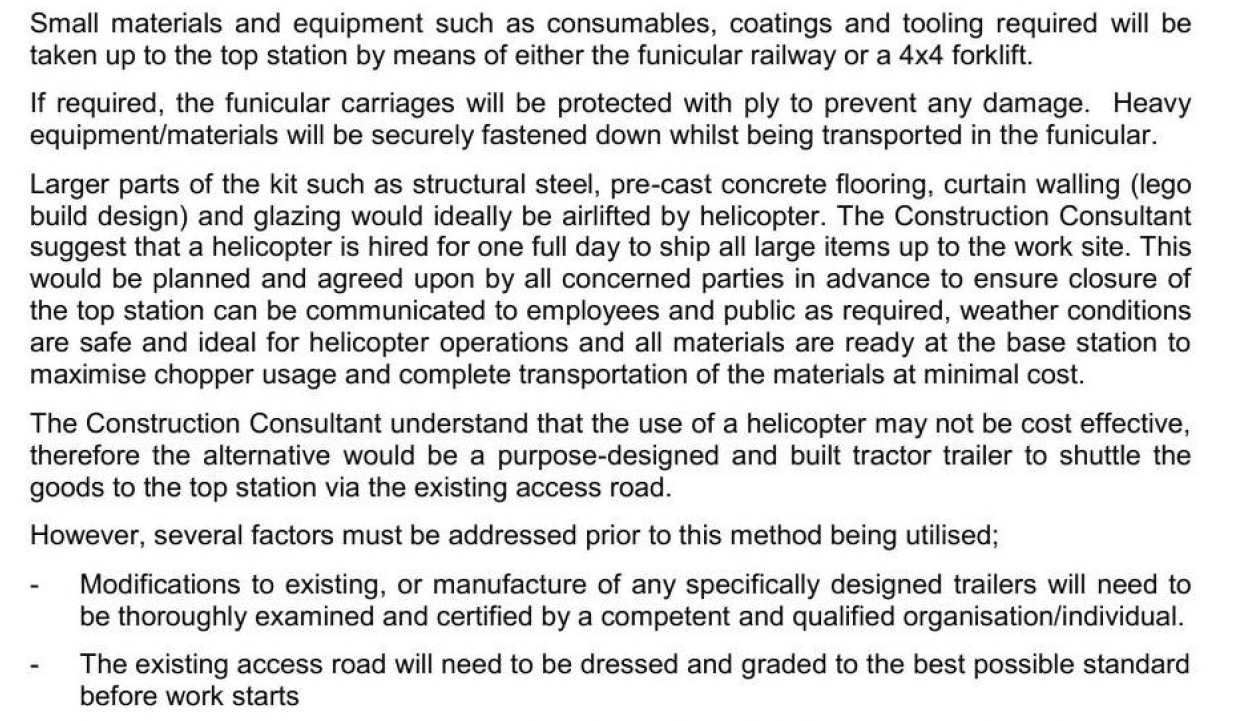
This statement is riddled with holes:
- If HIE and Natural Retreats were allowed the option of smaller materials – or indeed the workforce – being transported up and down the mountain by road that is what will happen. One justification for the funicular was it would reduce vehicle impact on the mountain in future – that, clearly, was a joke.
- Ideally, according to the CMS, materials will be lifted in by chopper – as per the funicular construction – BUT, since hiring a chopper for a day may not be cost effective, expect a tractor with trailer.
- And as a consequence of this the track will be “dressed and graded” – a euphemism for being re-aligned – before construction starts.
Even if the CNPA is minded to approve the application against its own policies it should still insist that the only means materials and people working on site can be brought in is by helicopter or the funicular. Failing to do this would be a complete betrayal of the standards developed in construction of the funicular.
Amazingly, all the ecological assessment has to say about the proposed track upgrade is as follows:
“Once constructed, regular accesses for maintenance etc. should be confined to the tracks. Provided
accesses remain confined to the tracks no additional impact is anticipated. If new accesses have to be constructed, additional lower plant survey would be recommended”
Nothing about where the stone to “dress” the track will come from, the likelihood of it eroding etc etc.
Waste management and pollution
Despite the existence of a waste management plan, the only explanation I can find of what is going to happen to the material excavated for the new foundations, such as how much material will be involved, how much left on the mountain and how much removed to where and how is from the Construction Method Statement:

That’s it, except for statements that vegetation will be save and replaced. This could mean anything and is I believe something which deserves attention from both SEPA and the CNPA.
Impact on plants and wildlife
While the ecological survey uncovered no rarities on the ground which would be affected by the artificial ski slope, the Ptarmigan was a different matter. Despite the area around the Ptarmigan being described as “trashed” the Mitigation and Enhancement Plan contains this statement:
One species (of lichen) was of national conservation concern (Cercidospora parva) and one species had local conservation value (Belonia incarnata). Three species were considered nationally scarce. Due to the small area of the proposed development site, it is expected that these species will be present in the wider Cairngorm landscape.
Now, I know enough about ecology and the practice of human science to know that just because only one example of something has been found, it doesn’t mean its the only one – but Natural Retreats hasn’t even bothered to find out whether the lichen of conservation concern exists elsewhere or not and how important the site is for the scarce populations of the other three species. To me, this shows better than anything else how little Natural Retreats cares: they were not even prepared to pay the surveyors to ascertain the extent to which Cercidospora parva might be threatened by the development or whether it could, realistically, be re-located.
The economic benefits of the development
I hope I have done enough to show that the proposed development will not conserve or enhance the landscape character or special qualities of the Cairngorms National Park and furthermore there are gaps and deficiencies in the planning application which should be matters of serious concern to the CNPA. In these circumstances the CNPA should ONLY approve a planning application which is in the national interest – its policy on that is very clear.
There is no need for the CNPA or anyone else to conduct a full economic critique of the proposals – though I (see here) and others have done so – because Natural Retreats’ own Supporting Statement makes it clear that these are JUST about trying to secure their own future at Cairngorm by increasing visitor numbers in summer. Rationally, one could argue that this won’t work because the reason people come to Aviemore and Glenmore is NOT to be shut up in a glass house in the clouds or ski on an artificial slope in summer but none of this matters because of Natural Retreats’ business objectives.
 Ignore the first bullet, which is laughable in the light of collapsing ski numbers and ski infrastructure, the aim, put basically, is not to attract lots more visitors to Speyside in summer but to attract people away from existing businesses.
Ignore the first bullet, which is laughable in the light of collapsing ski numbers and ski infrastructure, the aim, put basically, is not to attract lots more visitors to Speyside in summer but to attract people away from existing businesses.

Taking some of the summer visitor market might, if it works, create more year round employment at Cairngorm but only at the expense of other jobs in the strath and sucking even more money out of the area in inflated administrative charges. This is therefore an issue of local, not national importance, and as such can be rejected by the CNPA.
I am surprised local businesses have not picked up on this but guess that they, like the wider public, don’t know what is being proposed.
Luckily there is now an alternative
With the notable exception of the Lurcher’s Gully proposal, Highlands and Islands Enterprise has been used to having its own way at Cairngorm. It promises money – in the case of the Ptarmigan and Artificial Ski slope £4m – and has been confident the local community supports the proposals however senseless. People are not stupid, if its the only money going, take it.
Now, however, matters are not so simple as the Aviemore and Glenmore Community Trust have developed an alternative plan. You have no need to agree with it – see below – but there are NOW two well thought out options for Cairngorm. On the one hand an artificial ski slope and large new building, on the other a hydro scheme to power the lifts and mountain bike trails (which Natural Retreats has dismissed).
If a handful of volunteers can provide a well thought out alternative plan on so few resources, just think what the local community could do if they were in control. The publication of their plan makes HIE’s failure to consult on a new plan for Cairngorm, as promised, and piece meal approach look even worse. It shows up even further that what is being proposed at Cairngorm is NOT of national importance and that other investments are possible.
None of this of course will force HIE to think again – it has consistently ignored reality at Cairngorm – but, if the CNPA were to be brave enough to reject the planning application, and they have every reason for doing so, HIE might just be forced to consider the community alternatives.
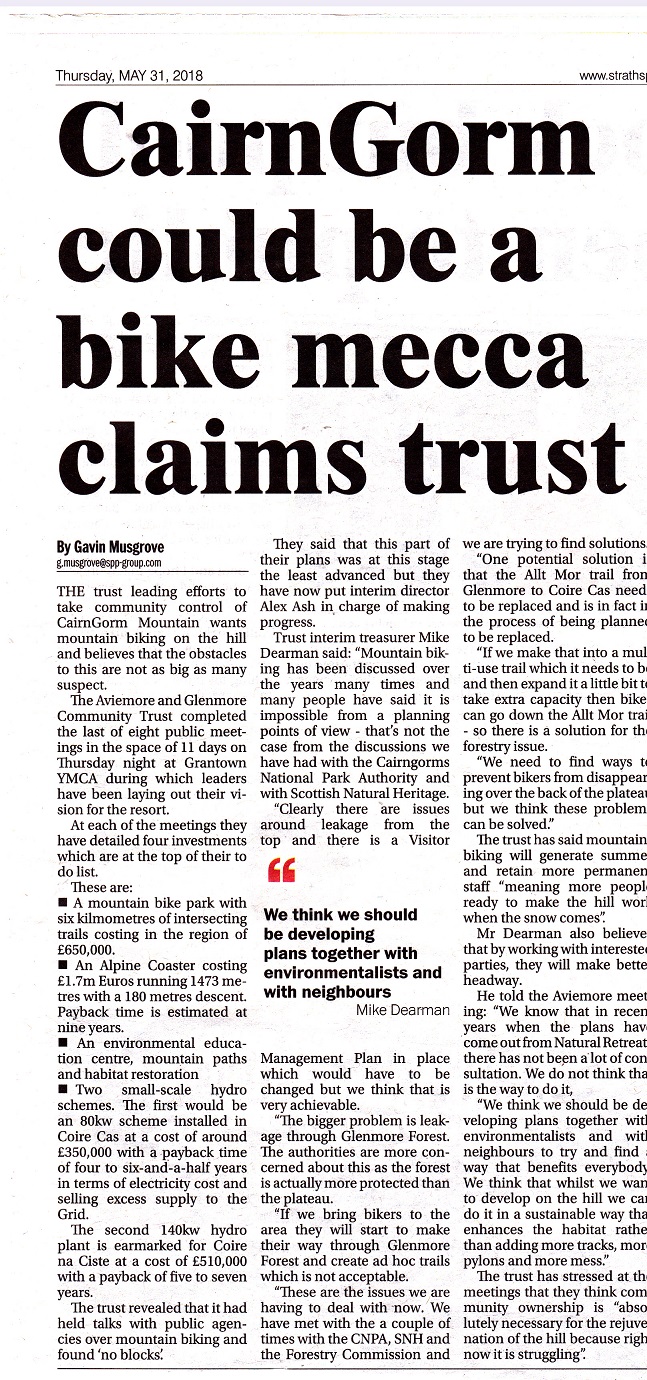

I spoke to one of the “Partners” of the Landscape Architects involved about a month ago ! A very eloquent “nippy sweetie” who so obviously did not want to be involved in any Controversy, but at the same time, unwilling to admit that in future his business would be remembered for this MESS if it goes ahead !
The mountain biking idea will generate way way more cash ,bikers will travel worldwide to ride a good trail spending more time even travelling to more Scottish mtb sites equals more cash ,uplifts should be able to take skis bikes boards with little to no gap in the season .aye and do something about that funicular sardine tin torture device, like cut the roof off, double length, seats all round and holes for kids spew to drain down. Fort William is mobbed every year for the mountain bike downhill and it would be hard to imagine the same for dry slope with blacked out viewing platform .
A very good argument against this ill-considered plan to squander yet more public money. Public consultation was minimal – a one day drop in event in Aviemore! There should have been several days of consultation in Aviemore as well as consultation events in many of Badenoch & Strathspey’s other towns. I also find it hard to believe that no adverse comments were received, certainly none of any substance were reported in the Design & Access Statement. You are right to be sceptical about the wording in the Construction Method Statement. It appears to be strong, but provides ample ‘elbow room’ to enable Natural Retreats to do what it wants:
– helicopter in equipment and materials, but who will decides if it is not “cost effective”
– upgrade of the track, but no details
– soils will be re-used wherever possible, but who decides what is possible. A very similar statement is in the Beachen Court housing development CMS (CNPA ref: 2016/0060/DET). When I questioned CNPA about why 20,000 to 30,000 tonnes of soil were removed from the site earlier this year in what seemed to be a contravention of the CMS, CNPA just responded emphasising the “wherever possible” words.
A key point that you rightly emphasise is questioning whether this proposed extension of Ptarmigan presents a social or economic benefit of national importance. It is very clear that this proposal is not and thus CNPA has an obligation to reject.
Lastly, as you say, why march ahead with this Natural Retreats proposal when there is a strong alternative case being put forward by the Community Trust. CNPA should have the sense to defer any decision on this proposal until the future management of Cairngorm Mountain is decided. Additionally, it would be close to lunacy for HIE to go ahead and try to fund this development with this strong challenge from the Community Trust still very much alive.
We cannot always bow to the pressure of increased footfall and resulting revenue. Certainly, should this project to be based on public funding, there must be a thorough debate and screening of any proposed plan. Once plans like this are cleverly pushed through with minimal publicity , any damage done to the environment of this beautiful mountain will never be undone. Open a public inquiry NOW.
STUART R ABERNETHY. Skier on Cairngorm for fifty three years.